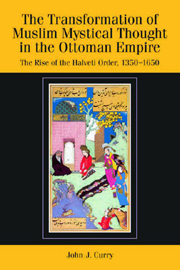 The Transformation of Muslim Mystical Thought in the Ottoman Empire
The Transformation of Muslim Mystical Thought in the Ottoman Empire from PART I - THE RISE AND SPREAD OF THE HALVETİ ORDER FROM ITS ORIGINS THROUGH THE ELEVENTH/SEVENTEENTH CENTURY
Published online by Cambridge University Press: 12 September 2012
The historical background for the rise of Islamic mysticism in its formative phases (second/eighth to seventh/thirteenth centuries) is beyond the scope of this work, and is treated in a much more thorough fashion elsewhere. However, since many of our sources for the Halveti are grounded in hagiographies (i.e. biographical works describing the lives and activities of pious figures), it is worth briefly tracing the roots of this literary genre and how it grew out of earlier periods of Islamic history.
After the revelation of the Qurɔan to the Prophet Muhammad, his companions and successors began to collect anecdotal materials about his sayings, acts, and personality in the hope of a better understanding of how to conduct their own lives. As the era of the Prophet and his immediate contemporaries receded into history, anecdotes about them having varying levels of acceptance among the Muslim community (known in Arabic as hadîth) began to circulate around the various regions that made up the early Arab empire. Some of these anecdotes were intended to clarify points of doctrine with regard to the new faith. However, this material was also mixed with other types of narratives and legends that detailed not only the Prophet, but his companions, the first four caliphs (successors to the Prophet as leaders of the Muslim community), and other well-known figures who developed a following. This sîra literature sometimes came into conflict with emerging doctrinal positions developing among religious leaders of the Muslim community.
To save this book to your Kindle, first ensure [email protected] is added to your Approved Personal Document E-mail List under your Personal Document Settings on the Manage Your Content and Devices page of your Amazon account. Then enter the ‘name’ part of your Kindle email address below. Find out more about saving to your Kindle.
Note you can select to save to either the @free.kindle.com or @kindle.com variations. ‘@free.kindle.com’ emails are free but can only be saved to your device when it is connected to wi-fi. ‘@kindle.com’ emails can be delivered even when you are not connected to wi-fi, but note that service fees apply.
Find out more about the Kindle Personal Document Service.
To save content items to your account, please confirm that you agree to abide by our usage policies. If this is the first time you use this feature, you will be asked to authorise Cambridge Core to connect with your account. Find out more about saving content to Dropbox.
To save content items to your account, please confirm that you agree to abide by our usage policies. If this is the first time you use this feature, you will be asked to authorise Cambridge Core to connect with your account. Find out more about saving content to Google Drive.